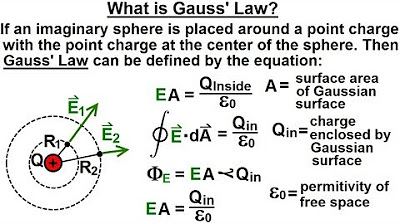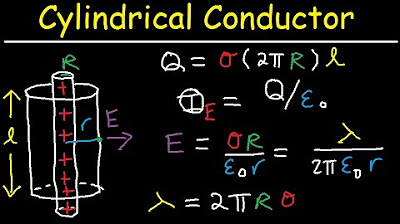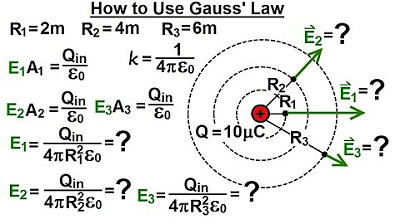Physics 37.1 Gauss's Law Understood (4 of 29) Gauss' Law Clarified
TLDRThe video script offers a detailed explanation of Gauss's law in the context of electricity. It describes how the electric flux, represented by electric field lines, remains constant regardless of the size of the Gaussian surface around a point charge. The script explains that the electric field strength can be determined by the charge and the distance from it, using the formula E = kQ/r^2, where k is a constant related to the permittivity of free space. The key takeaway is that Gauss's law allows us to calculate the electric field around any charged object by drawing a Gaussian surface and using the relationship between electric flux, charge, and the surface area.
Takeaways
- 🔋 Gauss's law helps us understand the relationship between electric flux and electric fields around a point charge.
- 🔵 The electric field around a point charge emanates radially outward in all directions.
- 🔄 Electric flux through a Gaussian surface is constant regardless of the surface's radius.
- 📏 Electric flux is the product of the electric field strength and the area of the surface.
- 🌀 As the radius of the Gaussian surface increases, the electric field strength decreases, but the surface area increases proportionally.
- 🔋 The electric field of a point charge is given by KQ/r², where K is 1/4πϵ₀ and ϵ₀ is the permittivity of free space.
- 🧮 Electric flux can be expressed as the charge inside the Gaussian surface divided by ϵ₀.
- 🌐 Gauss's law states that the electric flux through a Gaussian surface is equal to the enclosed charge divided by ϵ₀.
- 📐 For a spherical Gaussian surface, the area is 4πr², and this helps simplify calculations of electric flux and field strength.
- ⚡ Using Gauss's law, we can determine the electric field at any point around a charged object by drawing an appropriate Gaussian surface.
Q & A
What is Gauss's law and how does it relate to electric fields?
-Gauss's law, also known as Gauss's flux theorem, states that the electric flux through any closed surface is proportional to the total charge enclosed by the surface. It is a fundamental law in electromagnetism that relates the electric field to the charge distribution.
What is a Gaussian surface and why is it used in Gauss's law?
-A Gaussian surface is an imaginary closed surface used in the application of Gauss's law. It is used to calculate the electric flux through the surface, which is a measure of the electric field's influence through that surface.
How does the electric field around a point charge behave?
-The electric field around a point charge emanates radially outward from the charge. The electric field lines are perpendicular to the surface of the charge and spread out uniformly in all directions.
What is the relationship between electric flux and the electric field strength?
-Electric flux is defined as the product of the electric field strength (E) and the area (A) through which the field lines pass. It represents the total influence of the electric field through a given area.
Why is the electric flux through a Gaussian surface constant regardless of its size?
-The electric flux through a Gaussian surface is constant because the number of electric field lines passing through the surface does not change with the size of the surface. The weakening of the field with distance is compensated by the increase in surface area.
What is the formula for the electric field of a point charge?
-The electric field (E) of a point charge (Q) is given by the formula E = kQ / r^2, where k is Coulomb's constant and r is the distance from the charge.
What is the significance of the permittivity of free space (ε₀) in Gauss's law?
-The permittivity of free space (ε₀) is a constant that relates the electric field to the charge distribution. It appears in the formula for Coulomb's law and Gauss's law, and it quantifies the ability of free space to permit the electric field.
How does the area of a Gaussian surface affect the calculation of electric flux?
-The area of the Gaussian surface is directly proportional to the electric flux. As the area increases, the total electric flux through the surface also increases, assuming the enclosed charge remains constant.
Can you explain the cancellation of the 'r' terms in the calculation of electric flux for a spherical Gaussian surface?
-When calculating the electric flux for a spherical Gaussian surface, the r^2 term in the denominator of the electric field formula (E = kQ / r^2) cancels with the r^2 term in the area formula of the sphere (4πr^2), simplifying the expression for electric flux.
What is the final simplified form of Gauss's law for a point charge?
-The final simplified form of Gauss's law for a point charge is E * A = Q / ε₀, where E is the electric field strength, A is the area of the Gaussian surface, Q is the enclosed charge, and ε₀ is the permittivity of free space.
How can Gauss's law be used to find the electric field strength around a point charge?
-Gauss's law can be used to find the electric field strength by drawing a Gaussian surface around the point charge and using the relationship E = Q / (ε₀ * A). Since the flux (E * A) is constant and equal to Q / ε₀, the electric field strength can be determined.
Outlines
🔋 Understanding Gauss's Law with Point Charge
This paragraph explains the fundamental concept of Gauss's law in the context of a point charge, denoted as Q. It introduces the idea of placing Gauss's surfaces at various radii around the charge and describes how the electric field lines emanate from the charge, perpendicularly in all directions. The paragraph clarifies that the electric flux, which is the product of the electric field strength and the area of the surface, remains constant regardless of the size of the Gaussian surface due to the unchanging number of electric field lines. It also explains the mathematical relationship between the electric field of a point charge, the permittivity of free space, and the constant K, which is derived from Coulomb's law. The summary concludes with the derivation of Gauss's law, which states that the electric flux through a closed surface is equal to the charge enclosed divided by the permittivity of free space.
📚 Practical Application of Gauss's Law
The second paragraph delves into the practical application of Gauss's law, emphasizing its simplicity and utility in determining the electric field of any charge using Gaussian surfaces. It suggests that understanding Gauss's law allows for the calculation of the electric field strength around a point charge by drawing a Gaussian surface and applying the principles discussed in the first paragraph. The paragraph also reiterates the importance of Gauss's law in providing a constant measure of electric flux, which is a product of the electric field strength and the surface area of the Gaussian surface. It concludes with a brief mention of further examples that will be provided to clarify the application of Gauss's law, hinting at the educational nature of the content that follows.
Mindmap
Keywords
💡Gauss's Law
💡Point Charge
💡Electric Field
💡Gaussian Surface
💡Electric Flux
💡Permittivity of Free Space (ε₀)
💡Surface Area
💡Electric Field Lines
💡K (Coulomb's Constant)
💡Radii
Highlights
Introduction of Gauss's law and its significance in understanding the electric field around a point charge.
Explanation of the concept of a Gaussian surface and its use in calculating electric flux.
Description of electric field lines emanating from a point charge and their representation.
The constancy of electric flux through a Gaussian surface regardless of its size.
The relationship between electric field strength, surface area, and electric flux.
The formula for the electric field of a point charge and its derivation.
The definition of the constant K in terms of the permittivity of free space.
Calculation of electric flux using the formula for electric field strength and the area of a sphere.
The cancellation of terms in the electric flux equation leading to a simplified expression.
Gauss's law as a fundamental principle linking electric flux, charge, and the permittivity of free space.
The method to determine the electric field magnitude using the electric flux and surface area.
Rederivation of the point charge electric field equation using Gauss's law.
Gauss's realization and its practical application in determining the electric field around any charged object.
The demonstration of simple examples to clarify the application of Gauss's law.
The conclusion emphasizing the ease of using Gaussian surfaces to determine the electric field strength.
Transcripts
Browse More Related Video

Physics 37.1 Gauss's Law Understood (3 of 29) What is Gauss' Law?

Gauss law of electricity | Electrostatics | Physics | Khan Academy

Gauss Law Problems, Cylindrical Conductor, Linear & Surface Charge Denisty, Electric Field & Flux,

Physics 37.1 Gauss's Law Understood (5 of 29) How to Use Gauss' Law

Electric Field of a Sphere

Electric Flux and Gauss’s Law | Electronics Basics #6
5.0 / 5 (0 votes)
Thanks for rating: